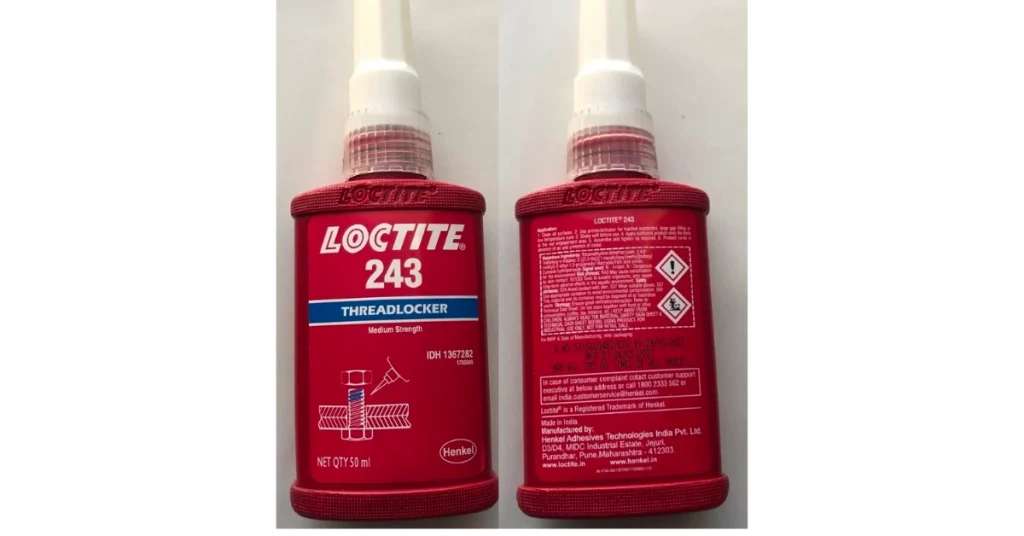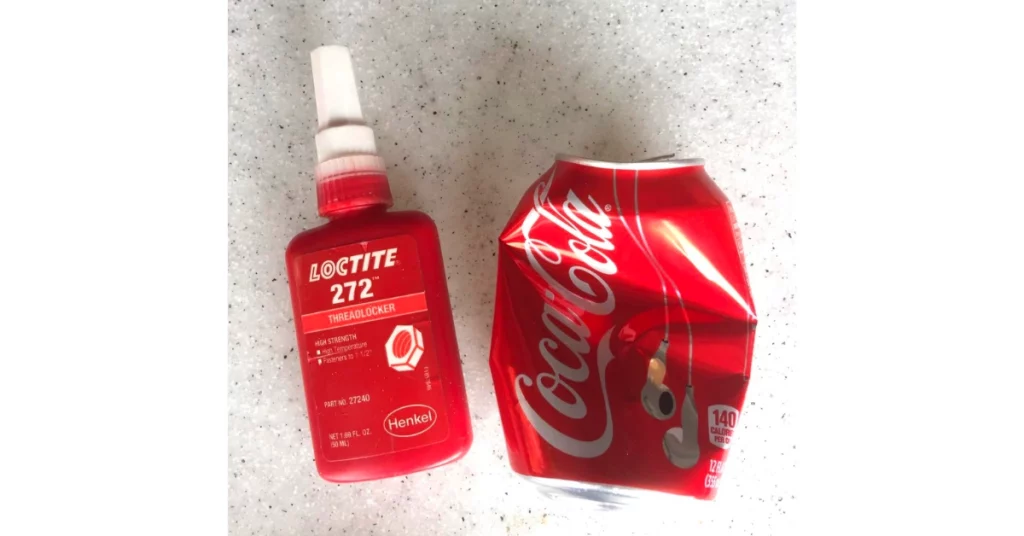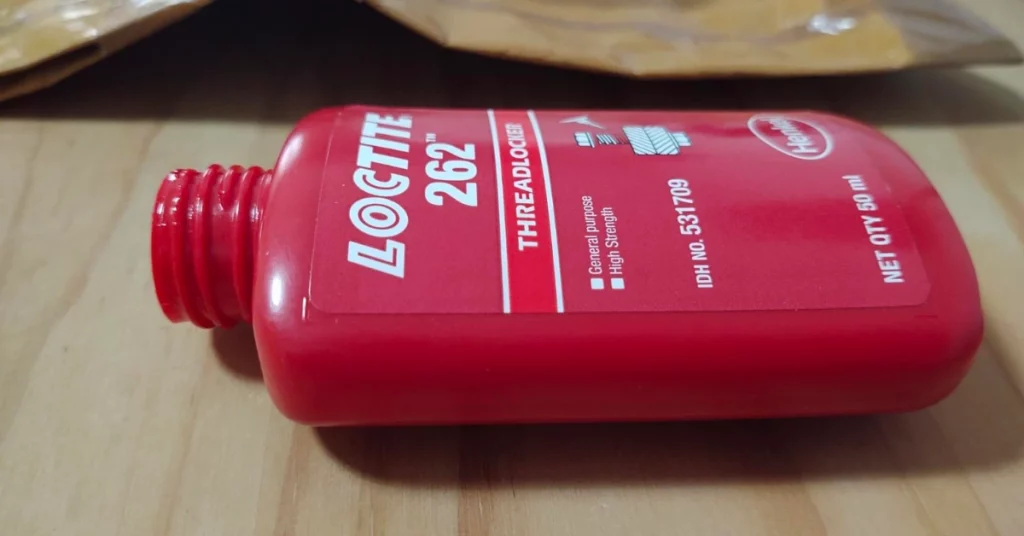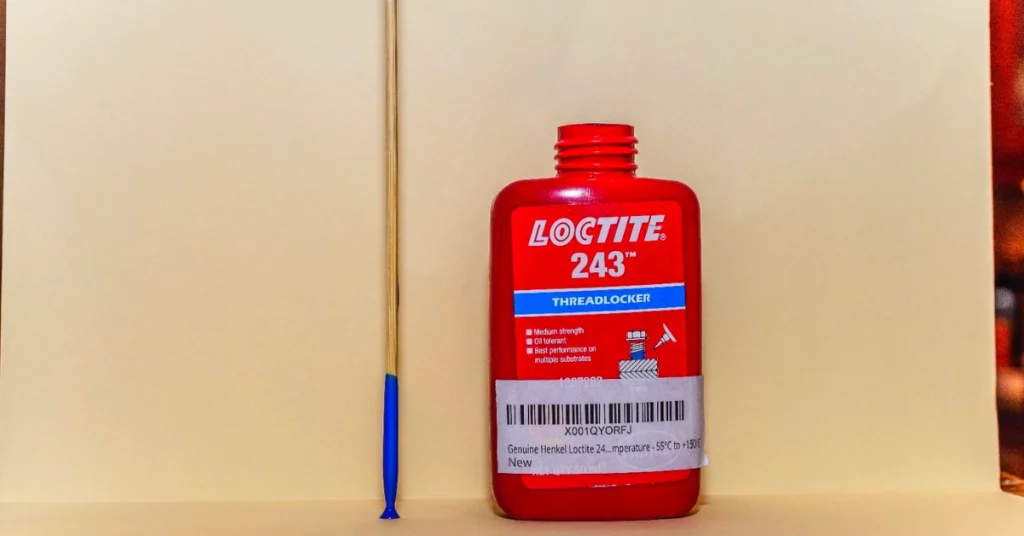Loctite is a well-known adhesive brand, and if you’re looking for a threadlocker, you might have run into multiple variants of Loctite threadlockers. Loctite threadlockers come in 4 different color choices, each with other uses.
Furthermore, in each colour pick, you have multiple options depending on which size screw or fasteners you use the adhesive for. So which one should you pick in the battle of Loctite Blue vs. Red, and why? I’ll go over Loctite Blue, and Loctite Red features, common uses, and differences in this article.
Read More: Yellow Loctite vs. Blue
Loctite Blue vs. Red
Overview of Loctite Threadlocker Blue

Loctite offers threadlockers in four different colours – Purple, Green, Blue and Red- each color indicates the strength of the glue. Some of the options you can find for Loctite Blue threadlockers are – 242, 243, 248 and 2432.
Loctite Blue works well with all metals and active and passive substrates. Furthermore, Blue Loctite is also tolerant to minor surface contamination from common cases, like spills from industrial oils – Cutting, lubrication, anti-corrosion and protection fluids.
Since Blue Loctite is a medium-strength threadlocker, you usually use it for general household purposes like your engine or car/truck parts, furniture, pumps and more. Furthermore, since it is medium-strength, you can disassemble the components easily in the future; you would only need household tools to dismantle them.
Multiple variants of Blue Loctite are available for different sizes of fasteners and screws, and you have options to buy a Blue Loctite for screws up to 20 mm.
Read More: Different Types of Loctite
Overview of Loctite Threadlocker Red

Loctite Red is the most robust variant of threadlockers offered by Loctite-Henkel, and similar to Loctite Blue, you have multiple options to choose from. Some common Loctite Red variants are – Loctite 262, 268, 271, 272 and more.
Loctite Red threadlocker is known for its superior bonding capabilities and permanent adhesion. Once Loctite Red cures completely, it creates a permanent, long-lasting bond. You would typically use Loctite Red for components you plan to avoid disassembling in the future.
Like its Blue counterpart, the Loctite Red is also tolerant of minor contamination from industrial oils like Cutting, Anti-corrosion or Protection Fluid. Loctite Red has multiple variants you can choose from, catering to your specific needs.
Loctite 271 is one of the most robust Loctite Red available, and you can use it for components where high strength and durability matter, like – Shock-absorber mounts or Wheel Studs.
While Loctite Red is hard to remove in the future, it is possible. However, you will need to follow some different procedures since more than just using household hand tools is required.
If you plan to disassemble components you used Loctite Red for, you will need to apply heat and, in many cases, certain chemical combinations alongside heat for disassembling.
Read More: Green Loctite vs. Red
Differences Between Loctite Blue And Red
Loctite Blue and Loctite Red are two different types of threadlockers produced by Henkel Loctite.
Loctite Blue is a medium-strength threadlocker that is ideal for securing bolts and nuts from accidental loosening due to vibration and shock, and it can be disassembled with hand tools. Loctite Red, on the other hand, is a high-strength threadlocker designed for permanent locking of threaded assemblies. It provides a strong and durable bond and is ideal for applications where vibration resistance and reliability are crucial. The main difference between Loctite Blue and Loctite Red is the strength of their bond and the intended use of each product.
Now that you know what Loctite Blue and Loctite Red are, let’s examine their more differences in-details.
Threadlocker Strength
Loctite Blue is a medium-strength threadlocker from Loctite-Henkel and can be disassembled using hand tools. However, that being said, Loctite Blue offers excellent bonding capabilities, and your components won’t come loose from vibration or constant motion quickly.
On the other hand, Loctite Red is the strongest threadlocker offered by Loctite-Henkel, and you would typically use it for components you do not plan to disassemble in the future. Most of the variants of Loctite Red provide superior protection against constant vibration. They are frequently vibration resistant so you can use them for industrial and household purposes.

Disassembly
Loctite Blue is a medium-strength adhesive, and you can easily disassemble components in the future. For disassembling Loctite Blue, you will only need household tools like – Hand Wrench. You will only need to apply 25-30% more torque than the original tightening torque of the Loctite Blue you got for separating the thread-locked screws/fasteners.
On the other hand, Loctite Red bonds permanently and requires some extra steps if you plan to disassemble the components later. You will need to apply localized heat of 250°C or more for the removal procedure. Furthermore, in some cases, you may also need to use certain chemical combinations alongside localized heat for disassembling the components.
Some solvents also dissolve Loctite Red, in case you need to, like the SF 790 or the SF 7601. You will also need to use mechanical abrasion alongside the solvents for properly disassembling the components.
Read More: Green Loctite vs. Blue
Set and Cure Time
Loctite Blue and Red take a similar amount of time to cure fully. Once you apply the threadlocker, you must let the components rest for around 24 hours for a complete cure.
Once you apply the adhesive, it takes around 5 to 15 minutes for it to start setting. After that, it requires approximately 24 hours for a complete cure.

Ideal Size of Fasteners
There are multiple variants of Loctite Blue available, and you can use them for screws and fasteners ranging from 6 mm in size to 22 mm in size. For example, one of the best Loctite Blue you can get is the 242, and you can use it for fasteners ranging from 6 mm to 19 mm in size.
Loctite Red also comes in various variants for different sizes of fasteners or screws. You can use Loctite Red for screws ranging from 6 mm to 25 mm in size. Loctite 271 is one of the strongest Loctite Red you can get, and you can use it for screws up to 25 mm in size.
Read More: Loctite 222 vs. Loctite 222ms
How to Choose the Right Loctite?
What is the strongest Loctite threadlocker?
What is Blue Loctite used for?
Is Blue Loctite strong enough?
What color of Loctite is the strongest?
Is Loctite Red permanent?
Is Blue Loctite hard to remove?
How long should you let blue Loctite sit?
What color is the weakest Loctite?
Do you need heat to remove blue Loctite?
Can you unscrew red Loctite?
How long should I let red Loctite sit?
Last Opinion
Loctite Blue and Red both are excellent adhesives that fit their purpose well. So, which one should you pick between the Loctite Blue vs. Red debate? It depends on your own specific needs and wants.
You can get Loctite Blue if you are looking for a medium-strength threadlocker for your household components, car or motor parts etc. Loctite Blue will be ideal for you if you plan to disassemble them.
On the other hand, you can get Loctite Red if you’re looking for a high-strength threadlocker for components that go through constant motion and vibration that you do not plan to disassemble in the future.

